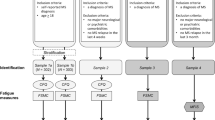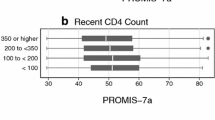Abstract
Purpose
To create cross-walk tables to associate scores for the Modified Fatigue Impact Scale (MFIS) with scores for the Patient Reported Outcome Measurement Information System (PROMIS) Fatigue Short Form (SF) in persons with Multiple Sclerosis (MS).
Methods
Cross-walk tables were created using equipercentile linking and based on data collected at one time point in a longitudinal study of persons with MS (N = 458). Validation of the tables was conducted using data collected at a subsequent time point (N = 444). Deviations between estimates and actual scores were compared across levels of fatigue. The impact of sample size on the precision of sample mean estimates was evaluated using bootstrapping.
Results
Correlations between deviations and fatigue level for the PROMIS Fatigue SF and MFIS were (−0.31) and (−0.30), respectively, indicating moderately greater deviations with lower fatigue scores. Estimated sample means were impacted by sample size.
Conclusions
Cross-walk tables allow data from studies using different measures of fatigue to be combined to achieve larger sample sizes and to compare results. These tables are valid for group-level analyses with sample sizes of 150 or greater.



Similar content being viewed by others
References
World Health Organization, & Multiple Sclerosis International Federation. (2008). Atlas multiple sclerosis resources in the world 2008. Geneva, Switzerland: World Health Organization.
Branas, P., Jordan, R., Fry-Smith, A., Burls, A., & Hyde, C. (2000). Treatments for fatigue in multiple sclerosis: A rapid and systematic review. Health Technology Assessment, 4, 1–61.
Multiple Sclerosis Council for Clinical Practice Guidelines. (1998). Fatigue and multiple sclerosis: Evidence-based management strategies for fatigue in multiple sclerosis. Washington, DC: Paralyzed Veterans of America.
Cella, D., Riley, W., Stone, A., Rothrock, N., Reeve, B., Yount, S., et al. (2010). The Patient-Reported Outcomes Measurement Information System (PROMIS) developed and tested its first wave of adult self-reported health outcome item banks: 2005–2008. Journal of Clinical Epidemiology, 63, 1179–1194.
Patient Reported Outcomes Measurement Information System (PROMIS). PROMIS. http://www.nihpromis.org. Accessed 20 May 2011.
Holland, P.W. (2007). Chapter 2. A framework and history for score linking. In N.J. Dorans, M. Pommerich, & P. W. Holland (Eds.), In Linking and Aligning Scores and Scales (pp. 5–30) Springer, New York.
Dorans, N. J. (2007). Linking scores from multiple health outcome instruments. Quality of Life Research, 16, 85–94.
Bamer, A. M., Cetin, K., Amtmann, D., Bowen, J. D., & Johnson, K. L. (2007). Comparing a self report questionnaire with physician assessment for determining multiple sclerosis clinical disease course: a validation study. Multiple Sclerosis, 13, 1033–1037.
Fisk, J. D., Ritvo, P. G., Ross, L., Haase, D. A., Marrie, T. J., & Schlech, W. F. (1994). Measuring the functional impact of fatigue: Initial validation of the Fatigue Impact Scale. Clinical Infectious Diseases, 18, S79–S83.
Fisk, J. D., Pontefract, A., Ritvo, P. G., Archibald, C. J., & Murray, T. J. (1994). The impact of fatigue on patients with multiple sclerosis. The Canadian Journal of Neurological Sciences, 21, 9–14.
Kos, D., Kerckhofs, E., Carrea, I., Verza, R., Ramos, M., & Jansa, J. (2005). Evaluation of the Modified Fatigue Impact Scale in four different European countries. Multiple Sclerosis, 11, 76–80.
Flachenecker, P., Kumpfel, T., Kallmann, B., Gottschalk, M., Grauer, O., Rieckmann, P., et al. (2002). Fatigue in multiple sclerosis: A comparison of different rating scales and correlation to clinical parameters. Multiple Sclerosis, 8, 523–526.
Tellez, N., Rio, J., Tintore, M., Nos, C., Galan, I., & Montalban, X. (2005). Does the Modified Fatigue Impact Scale offer a more comprehensive assessment of fatigue in MS? Multiple Sclerosis, 11, 198–202.
Riley, W. T., Rothrock, N., Bruce, B., Christodolou, C., Cook, K., Hahn, E. A., et al. (2010). Patient-Reported Outcomes Measurement Information System (PROMIS) domain names and definitions revisions: Further evaluation of content validity in IRT-derived item banks. Quality of Life Research, 19, 1311–1321.
Christodoulou, C., Junghaenel, D. U., DeWalt, D. A., Rothrock, N., & Stone, A. A. (2008). Cognitive interviewing in the evaluation of fatigue items: Results from the Patient-Reported Outcomes Measurement Information System (PROMIS). Quality of Life Research, 17, 1239–1246.
Lai, J. S., Cella, D., Choi, S., Junghaenel, D. U., Gershon, R., & Stone, A. (2011). How item banks and their application can influence measurement practice in rehabilitation medicine: A PROMIS fatigue item bank example. Archives of Physical Medicine and Rehabilitation, 92, S20–S27.
Fong, T. G., Fearing, M. A., Jones, R. N., Shi, P., Marcantonio, E. R., Rudolph, J. L., et al. (2009). Telephone interview for cognitive status: Creating a crosswalk with the Mini-Mental State Examination. Alzheimer’s & Dementia, 5, 492–497.
Leucht, S., Kane, J. M., Etschel, E., Kissling, W., Hamann, J., & Engel, R. R. (2006). Linking the PANSS, BPRS, and CGI: Clinical implications. Neuropsychopharmacology, 31, 2318–2325.
Holzner, B., Bode, R. K., Hahn, E. A., Cella, D., Kopp, M., Sperner-Unterweger, B., et al. (2006). Equating EORTC QLQ-C30 and FACT-G scores and its use in oncological research. European Journal of Cancer, 42, 3169–3177.
Dorans, N. J. (2004). Equating, concordance, and expectation. Applied Psychological Measurement, 28, 227–246.
Kolen, M. J. (2004). Linking assessments: Concept and history. Applied Psychological Measurement, 28, 219–226.
Muthén, L. K., & Muthén, B. O. (2009). Mplus: statistical software version 5.21. Los Angeles, CA: Muthén & Muthén.
Reeve, B. B., Hays, R. D., Bjorner, J. B., Cook, K. F., Crane, P. K., Teresi, J. A., et al. (2007). Psychometric evaluation and calibration of health-related quality of life item banks: Plans for the Patient-Reported Outcomes Measurement Information System (PROMIS). Medical Care, 45, S22–S31.
Yu, C. Y. (2002). Evaluating cutoff criteria of model fit indices for latent variable models with binary and continuous outcomes. Doctor of Philosophy in Education. Los Angeles: University of California.
Acknowledgments
The contents of this manuscript were developed under grants from the Department of Education, National Institute on Disability and Rehabilitation Research grant numbers H133B031129 and H133B080025, and the National Institute of Arthritis and Musculoskeletal and Skin Diseases, National Institute of Health (Grant 5U01AR052171). However, these contents do not necessarily represent the policy of the Department of Education, and you should not assume endorsement by the Federal Government.
Author information
Authors and Affiliations
Corresponding author
Rights and permissions
About this article
Cite this article
Noonan, V.K., Cook, K.F., Bamer, A.M. et al. Measuring fatigue in persons with multiple sclerosis: creating a crosswalk between the Modified Fatigue Impact Scale and the PROMIS Fatigue Short Form. Qual Life Res 21, 1123–1133 (2012). https://doi.org/10.1007/s11136-011-0040-3
Accepted:
Published:
Issue Date:
DOI: https://doi.org/10.1007/s11136-011-0040-3




